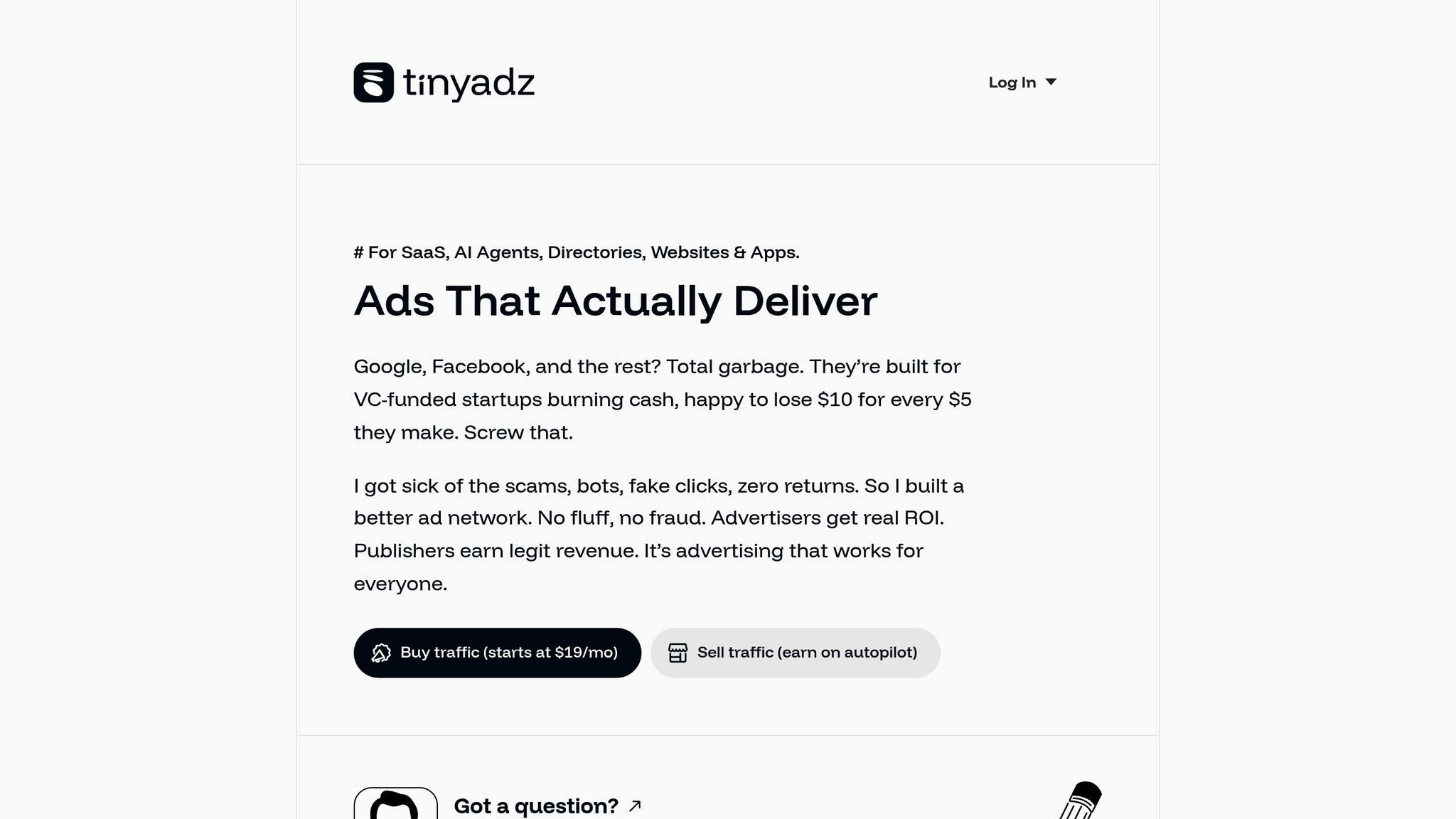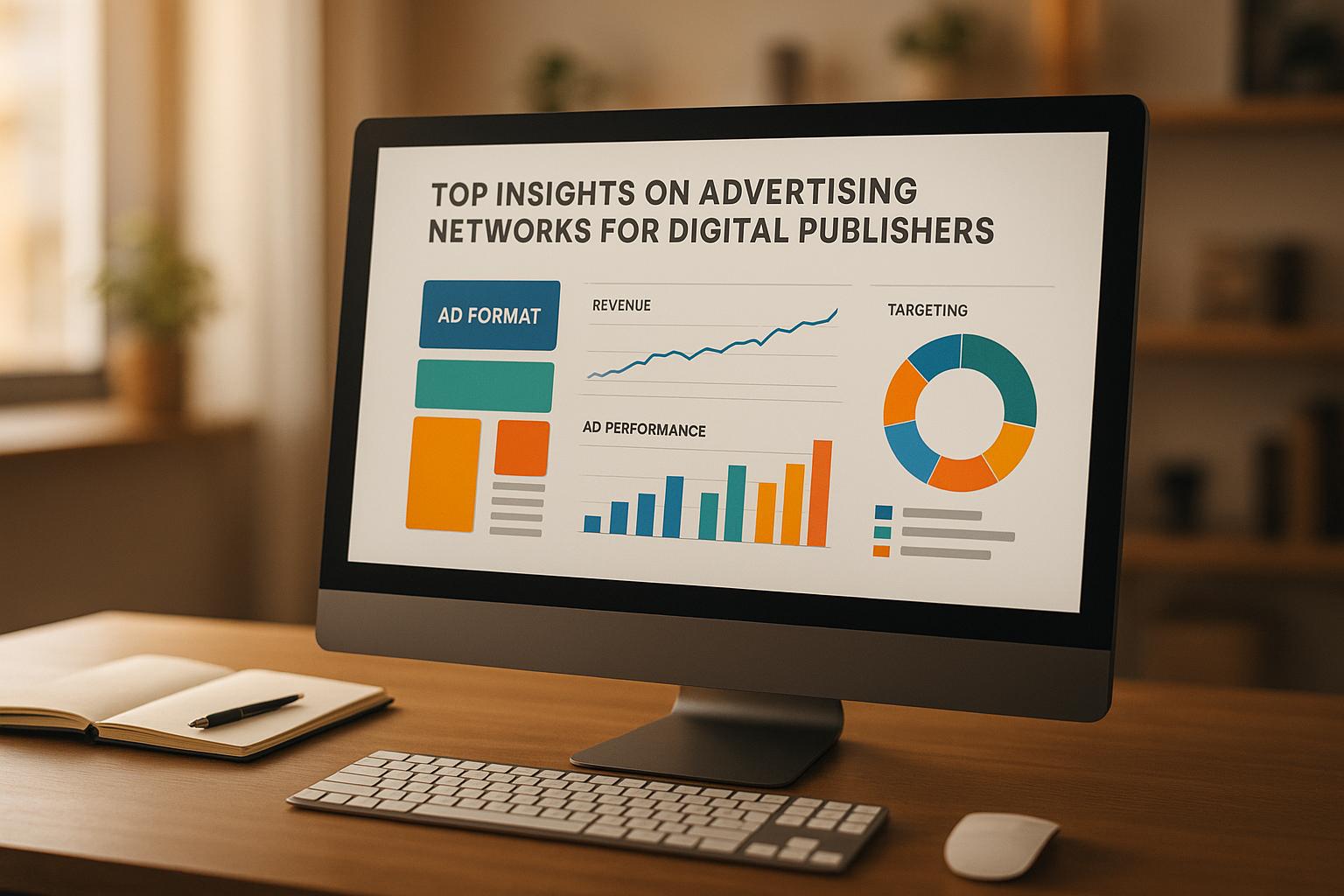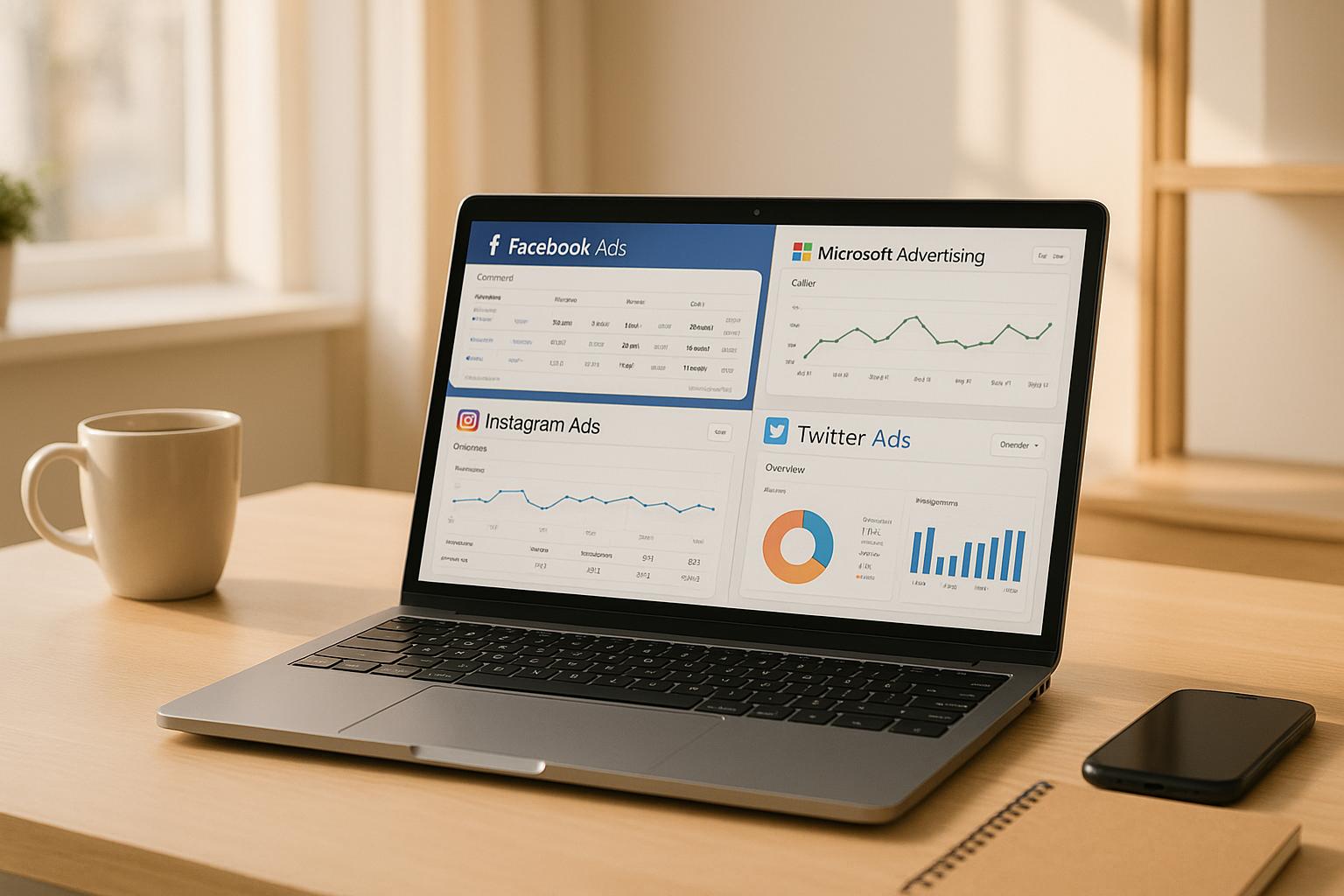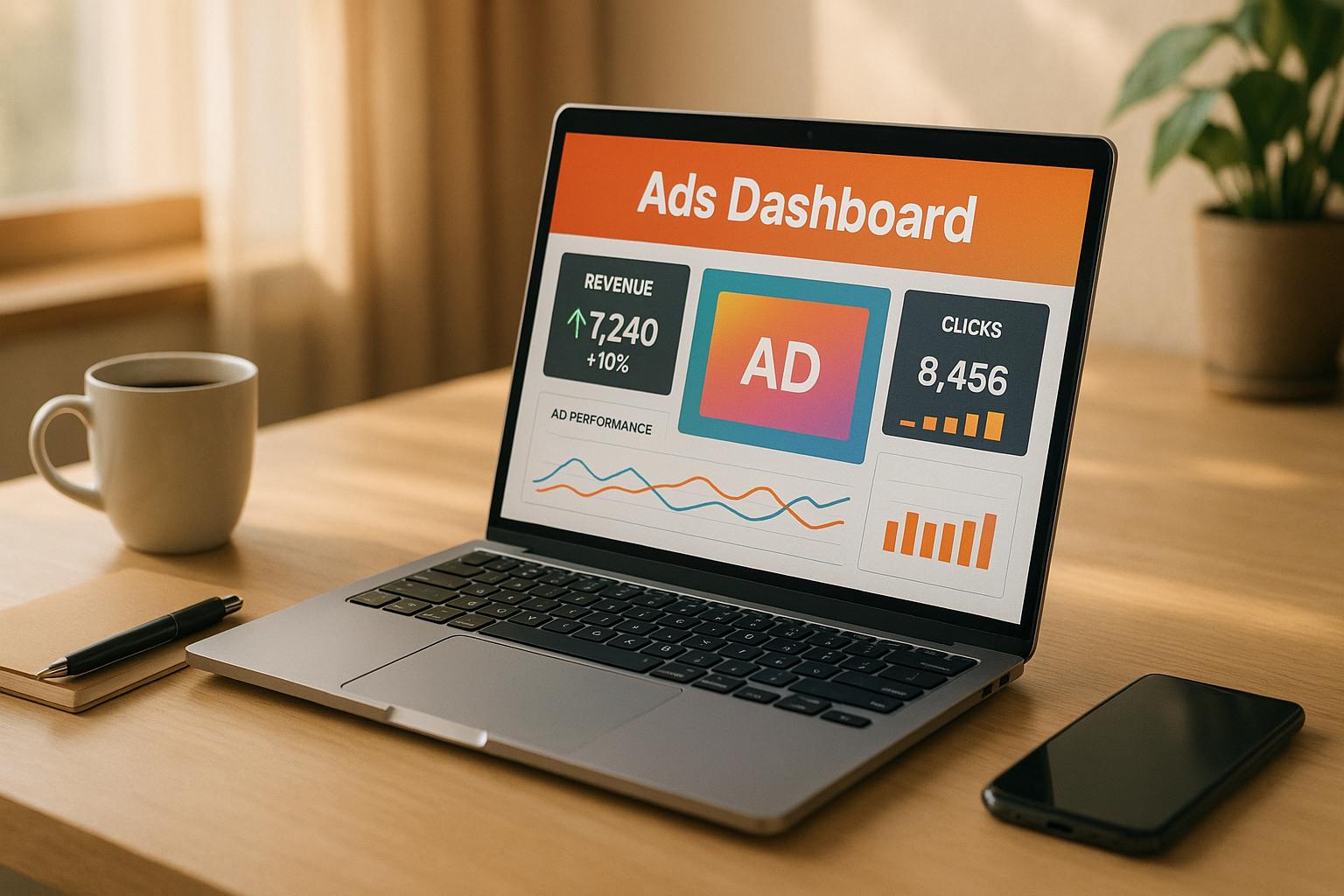Digital publishers, it's time to pay attention: Advertiser solutions are essential for staying competitive and increasing revenue in today’s digital advertising landscape. These tools streamline ad management, improve targeting, and build trust with advertisers. Here’s why they matter:
- What They Do: Advertiser solutions connect publishers and advertisers, helping publishers monetize content through smarter ad inventory management and advanced tools like fraud prevention and audience segmentation.
- Why They’re Important: With ad fraud costing billions and advertisers demanding transparency, these solutions help publishers prove their value and attract better deals.
- Key Benefits:
- Boost revenue with ad optimization tools like header bidding.
- Deliver personalized ads using audience segmentation.
- Build advertiser trust with verified, fraud-free traffic.
- Real-World Impact: Publishers using these tools see higher ad viewability, better engagement, and stronger advertiser relationships.
Takeaway: Advertiser solutions are your key to thriving in the evolving digital ad space. Start using platforms like TinyAdz to simplify ad management, diversify revenue streams, and stay ahead of industry changes.
How Data & Audience Solutions Help Publishers Navigate the Ad Ecosystem
Main Parts of Advertiser Solutions
Advertiser solutions provide publishers with the necessary tools to monetize their content, manage ad inventory, and address the challenges of digital advertising. Below, we dive into the essential components that power effective monetization for publishers.
Ad Revenue Optimization Tools
Ad revenue optimization tools are a cornerstone for publishers aiming to boost earnings. These tools use automated bidding, data insights, and strategic ad placement to maximize revenue. One standout method is header bidding, which allows multiple demand sources to bid at the same time, driving up competition and, in turn, revenue. Publishers can opt for client-side or server-side header bidding, with the latter often regarded as the more advanced choice.
Data analytics play a critical role by offering insights into audience behavior, helping publishers make smarter decisions about ad formats and placement. A/B testing further refines these strategies, ensuring better ad performance over time.
The stakes are high - ad blocking is expected to cost publishers $54 billion in lost revenue globally by 2024. Optimization tools help mitigate these losses by ensuring ads are relevant, user-friendly, and seamlessly integrated into the browsing experience.
Audience Targeting and Segmentation
Audience targeting and segmentation empower publishers to deliver personalized ads that resonate with users while meeting advertisers' goals. By dividing audiences into groups based on shared traits or behaviors, publishers can enable more precise targeting and achieve higher engagement rates.
Statistics highlight the importance of personalization: 91% of consumers are more likely to shop with brands that tailor their communication, especially with customized offers. Additionally, 72% of consumers only engage with marketing messages that align with their interests. Segmentation tools analyze factors like demographics and user behavior to create detailed audience profiles, allowing advertisers to craft messages that connect with the right people while making efficient use of their budgets.
"As there is an enormous volume of data placed at multiple locations the publishers and digital agencies find it difficult to understand the mass audience. And, it is a consumer-driven digital age! Hence, it is essential for publishers to concentrate more on individual consumer needs instead of endowing with generic content." - headerbidding.co
Tracking key metrics like click-through rates and conversion rates is essential for measuring the success of these strategies.
Transparency and Fraud Prevention
Transparency and fraud prevention are vital for building trust between publishers and advertisers. Ad fraud is a massive issue, costing the digital advertising industry over $87 billion by 2022. This makes fraud prevention a top priority for advertiser solutions. Publishers who maintain low levels of fraudulent traffic can showcase the quality of their inventory, encouraging advertisers to invest with confidence.
Recent advancements have significantly reduced ad fraud, saving billions. A multi-layered approach - combining proprietary technologies, strategic collaborations, and independent audits - has proven effective in protecting ad inventories.
"Ad fraud isn't just a buyer issue – it also eats into a publisher's resources and monetization opportunities. Like advertisers, publishers also benefit from technology that easily identifies and acts on invalid traffic to prevent fraud in real-time. This helps them prove the value of their inventory to media buyers." - Pieter Mees, VP Video & Publisher Product, DoubleVerify
To combat fraud, publishers should adopt best practices such as monitoring ad exchanges, using fraud detection tools, sourcing traffic ethically, and setting benchmarks for fraudulent activity. Partnering with third-party solutions and working with organizations that hold TAG certifications further enhances credibility and ensures protection.
Transparency also plays a key role in earning consumer trust. For instance, 63% of consumers are more likely to trust brands that provide clear information about their products and services. Similarly, 82% of marketers agree that transparency is crucial for building brand trust in digital advertising.
How to Use Advertiser Solutions
To effectively implement advertiser solutions, it’s essential to use the right tools strategically. This ensures revenue growth while maintaining the high standards advertisers expect. Let’s dive into practical ways to make these solutions work.
Using Platforms Like TinyAdz

TinyAdz is a platform designed to maximize monetization across multiple channels, offering opportunities beyond just traditional website ads. Its standout feature? It works with various content formats and audience types, and there’s no minimum traffic requirement.
- Website monetization: TinyAdz helps publishers strategically place banner ads and use directory monetization features. This gives publishers more control over the quality and relevance of displayed ads, which is crucial since poorly targeted ads can hurt user experience and engagement.
- Social media monetization: This tool seamlessly integrates targeted ads into social platforms, maintaining authenticity - especially effective for niche publishers with dedicated audiences.
- Newsletter placements: Email newsletters often boast higher engagement rates than websites, which allows publishers to charge premium rates for ad placements directly in subscribers’ inboxes.
- Event monetization: TinyAdz also extends its reach into event-based advertising, providing unique opportunities for advertisers to connect with audiences.
The key to success with TinyAdz? Building a loyal audience within a specific niche. Content that resonates deeply with a target group attracts advertisers looking for meaningful engagement.
Building Trust Through Verified Traffic
Once monetization strategies are in place, publishers need to focus on maintaining trust with advertisers. This starts with verifying traffic and embracing transparency. With digital ad fraud expected to hit $172 billion globally by 2028, advertisers are becoming more cautious about where they allocate budgets.
- Traffic verification: Automated tools ensure ads reach their intended audience, guaranteeing traffic quality, viewability, and brand safety. For example, Assembly Digital partnered with GeoEdge to gain full visibility into programmatic ads, enforcing strict quality policies and improving user experience.
- Transparent reporting: Openly sharing traffic acquisition methods and detailed audience insights builds advertiser confidence.
"Transparency and trust are the cornerstones of a healthy digital ecosystem." – DoubleVerify
To strengthen relationships further, publishers can offer guarantees, such as fraud-free traffic or high viewability rates. As third-party cookies lose reliability, leveraging first-party data to create dynamic, verified audience identifiers becomes increasingly critical.
Custom Matching Between Publishers and Advertisers
Beyond traffic verification, publishers can boost revenue by aligning their audience with advertisers’ specific needs. Establishing meaningful connections between the two parties often leads to better outcomes.
- Custom packages: Publishers can craft tailored advertising solutions based on detailed audience demographics, interests, and behaviors. These specialized packages often command higher CPMs.
- Telco-verified IDs: These provide more accurate audience matching compared to traditional cookies, which typically have match rates between 40% and 60%.
Building strategic partnerships is another way to secure premium pricing. By understanding advertiser goals, sharing valuable audience insights, and adjusting campaigns based on performance, publishers can foster long-term relationships. Tracking metrics like click-through rates, conversions, and engagement allows publishers to fine-tune their strategies and improve future campaigns.
Benefits of Advertiser Solutions for Niche Publishers
Niche publishers often face distinct challenges, but advertiser solutions offer a way to achieve steady growth and strengthen relationships with advertisers. By applying practical strategies, these tools can make a real difference in how niche publishers operate and thrive.
Generating Revenue Across Multiple Channels
For niche publishers, diversification is key. On average, successful publishers tap into six different revenue streams. Advertiser solutions play a big role here, providing tools that work seamlessly across websites, newsletters, social media, and even events.
Take Justin Pardee from Raincross Gazette, for example. He organizes email sales into three tiers, with prices ranging from $10,000 for industry exclusivity to $30,000 for premium content marketing packages. Angie Thompson, on the other hand, launched FishingTackleNewswire, where companies pay $1,000 annually for unlimited newsletter placements.
SpaceNews has a different approach, offering press release packages priced from $799 for single releases to $3,400 for bulk distribution. Meanwhile, Builder Innovator focuses on annual events, giving vendors access to landing pages and premium content options.
This kind of revenue diversity not only boosts income but also helps build trust with advertisers.
Strengthening Advertiser Trust and Credibility
Trust is the foundation of successful advertiser relationships, and niche publishers bring immediate credibility to the table. In fact, 68% of publishers see direct deal revenue as the top growth opportunity for 2025.
Freestar, for instance, achieved a 147% increase in private marketplace deals by maintaining a minimum viewability rate of 70%. Similarly, Unilever partnered with verified publishers for a targeted campaign that boosted brand awareness by 15% while cutting costs by 20%.
Advertiser solutions help publishers maintain high standards by offering tools for traffic verification, fraud prevention, and audience analytics. When publishers can ensure a brand-safe environment, advertisers are more willing to pay premium rates.
But it’s not just about revenue and trust - streamlined ad management is another game-changer for niche publishers.
Streamlining Ad Management
Managing ads can be a headache, but advertiser solutions make it easier by centralizing the process. Ad servers simplify integration, while optimized ad exchange stacks can deliver CPM improvements of 40–150% compared to basic setups.
Publift, for example, has increased client ad revenue by 55% by streamlining workflows. In Switzerland, audienzz AG introduced Emvoy through Passendo, creating unique advertising opportunities for premium publishers. Similarly, Roularta Media Group integrated email ad servers to simplify placements and enhance subscription data management.
Platforms like TinyAdz, as discussed earlier, take it a step further by consolidating ad operations across websites, social media, newsletters, and events. With automation handling delivery, optimization, and reporting, publishers can manage multiple formats without needing advanced technical skills. This frees up time to focus on creating quality content while the platform takes care of the complex backend work.
sbb-itb-957fd63
Solving Common Digital Advertising Problems
Digital advertising isn't without its hurdles, but there are practical solutions to tackle these challenges effectively. These methods not only protect revenue but also maintain advertiser trust. Let’s dive into some of the most pressing issues and how to address them.
Fighting Fake Traffic and Fraud
Fake traffic is a major headache, draining advertising budgets and skewing performance metrics. Over 40% of all online traffic is invalid, and in 2024, advertisers are expected to lose more than $71 billion to fake or fraudulent traffic. Small and medium-sized businesses feel this impact even more, with an average of 25% of their digital ad budgets being wasted on invalid traffic this year.
"Invalid traffic includes any clicks or impressions that may artificially inflate an advertiser's costs or a publisher's earnings. This can be done by mistake or deliberately with the intention of fraud. From the perspective of the advertisers, such traffic doesn't end up becoming good leads (ultimately not resulting in any revenue), making the impressions and clicks of no value." - Google AdSense
Fake traffic can come from various sources, such as automation (20.1%), click hijacking (16.6%), disabled JavaScript (13.6%), VPN usage (13.6%), and malicious bots (8.1%). Direct traffic has the highest rate of fake impressions at 22.1%, followed by paid streaming at 11.1%. To combat this, publishers should keep a close eye on referral sources and work with vendors using tools like ads.txt, ads.cert, app-ads.txt, TAG Certification, and sellers.json.
Advanced verification tools are also a game-changer. Some scanners can detect up to 70% more bot traffic compared to other leading solutions, providing real-time protection against fraudulent activity.
Maintaining Transparency and Compliance
Transparency is essential for fostering trust in digital advertising. Publishers need to be upfront about how they collect data, target ads, and measure performance. This openness reassures advertisers and strengthens relationships.
In Q1 2024, Assembly Digital, a Canadian media company, partnered with GeoEdge to improve ad quality and compliance. Using tools like AdWatch, keyword search, and brand filtering, they gained full visibility into their programmatic ads. This streamlined their compliance checks, reducing oversight from daily to weekly, while also boosting user experience and key metrics like return visits and click-through rates.
Transparency efforts should extend to areas like viewability, brand safety, fraud prevention, and geo-targeting. Publishers can build trust by sharing real-time analytics, offering clear metrics on impressions, click-through rates, and conversions. For example, transparency initiatives have pushed ad viewability rates to 65.4% in 2021, and 82% of marketers in a TrustRadius survey cited transparency as critical for building brand trust.
Keeping Up with Industry Changes
The digital advertising world is constantly evolving, with new regulations and technologies reshaping the landscape. Advertisers must stay agile to navigate these changes while safeguarding revenue and trust. In the US alone, 11 new state-level data privacy laws have come into effect this year, with more anticipated in 2025.
"Essentially, the CCPA, CPRA, and the other data privacy acts that are popping up around the US are establishing legal enforcement mechanisms around personal control of one's personal data and codifying many of the core principals of our industry - namely, transparency, notice, and the right to opt out." - Derek Zolner, Basis General Counsel
With privacy laws tightening, first-party data has become more critical than ever. Platforms like TinyAdz simplify compliance by offering integrated tools for audience monetization and regulatory adherence. This eliminates the need for juggling multiple solutions, allowing publishers to manage everything from a single platform.
Staying compliant requires constant vigilance. Regularly check creative assets and landing pages before uploading them to ad servers, and monitor live campaigns for malicious activity. Implementing strong data governance policies is also essential to ensure security and compliance as regulations continue to evolve.
Conclusion: Why Digital Publishers Need Advertiser Solutions
The digital advertising world is changing fast, and publishers who adapt by using advertiser solutions set themselves up for long-term success. These tools not only help build trust with advertisers but also open doors to steady revenue growth.
Key Takeaways
Studies reveal that direct ads boast viewability rates of up to 70%, compared to just 50% for programmatic ads. That’s a clear revenue opportunity publishers can’t afford to overlook.
Quality matters more than ever. Savvy marketers are shifting their focus from sheer volume to environments that offer accountability and authentic human interaction, rather than chasing clicks.
Using advertiser solutions not only boosts revenue but also enhances audience targeting, strengthens brand safety, and prevents ad fraud. These tools allow publishers to create tailored solutions that ensure steady income streams. Implementing secure, bot-free practices is essential to meet advertisers' expectations for transparency.
The competitive edge goes to those who adapt. Publishers who embrace advertiser solutions enjoy higher ad viewability, better engagement, stronger advertiser ROI, and trusted audience targeting. These benefits make it clear: now is the time to act.
Next Steps for Publishers
To get started, consider platforms like TinyAdz, which help monetize websites, social media, newsletters, and events with verified traffic and personalized ad placements.
Begin with simple steps like adding registration forms, paywalls, and CAPTCHAs to block bots. Then, expand your efforts with programmatic direct deals, affiliate marketing, and sponsored content. Successful publishers in 2025 will rely on diverse revenue streams that serve their audience effectively.
Stay ahead of data privacy laws by being transparent about data collection and giving users control over their information. As consumer habits and technology evolve, keep testing new ad formats and environments using real-time data insights.
FAQs
How do advertiser solutions help publishers prevent ad fraud and build trust with advertisers?
Digital publishers are stepping up their game against ad fraud with the help of AI and machine learning. These cutting-edge tools work in real-time to spot and block fraudulent activity, ensuring advertisers pay only for legitimate, high-quality traffic. The result? Fewer financial losses and greater confidence in ad campaigns.
By prioritizing transparency and consistently driving genuine engagement, publishers can showcase the true worth of their ad inventory. This approach not only safeguards revenue but also builds trust, paving the way for stronger, long-lasting relationships with advertisers. Ultimately, it contributes to a more dependable and trustworthy advertising landscape.
What are the main features of ad revenue optimization tools, and how do they help digital publishers?
Ad revenue optimization tools are built to help digital publishers get the most out of their ad spaces, boosting earnings through smarter ad performance and better efficiency. Here’s how they do it:
- Data Analytics: These tools dig into user behavior and demographics to serve up ads that feel more relevant. The result? Higher engagement and better revenue potential.
- Programmatic Advertising: By automating ad placements and real-time bidding, these systems make sure every bit of ad inventory is used effectively.
- A/B Testing: Trying out different ad formats and placements allows publishers to see what works best for their audience, fine-tuning strategies to maximize profits.
Using these features, publishers can fine-tune ad targeting, keep users engaged, and boost revenue - all while fostering stronger connections with advertisers.
Why is audience targeting and segmentation so important for digital publishers, and how does it boost ad engagement?
Why Audience Targeting and Segmentation Matter for Digital Publishers
Audience targeting and segmentation play a crucial role in helping digital publishers deliver ads that truly connect with specific groups of users. By dividing audiences based on factors such as demographics, interests, and online behaviors, publishers can craft ad experiences that feel more personal and relevant. This approach doesn’t just grab attention - it boosts engagement, increases click-through rates, and fosters a stronger relationship with the audience.
When ads align with what users genuinely care about, everyone wins. Advertisers see better results, and publishers enjoy higher revenue. Tools powered by AI take this to the next level by analyzing user data in real time. They can predict behaviors and fine-tune ad placements to ensure maximum impact. The result? Ads that feel more meaningful to users while driving better performance and creating new revenue opportunities for publishers.


